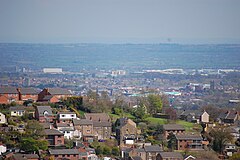Coedpoeth
| Coedpoeth | |
|---|---|
 A part of Coedpoeth in relation to Wrexham |
|
| Coedpoeth shown within Wrexham | |
| Population | 4,702 (2011 census) |
| OS grid reference | SJ285515 |
| Community |
|
| Principal area | |
| Ceremonial county | |
| Country | Wales |
| Sovereign state | United Kingdom |
| Post town | WREXHAM |
| Postcode district | LL11 |
| Dialling code | 01978 |
| Police | North Wales |
| Fire | North Wales |
| Ambulance | Welsh |
| EU Parliament | Wales |
| UK Parliament | |
| Welsh Assembly | |
Coedpoeth (Welsh pronunciation: [kɔidpɔiθ]) is a village and community within Wrexham County Borough in Wales.
The etymology of the placename is from Welsh coed "wood" with poeth meaning, in its original sense, "burnt", although the modern Welsh word translates as "hot". The name therefore translates roughly as "burnt wood", perhaps referring to the charcoal burning heritage in the village and local woods.
In its early history the area known as Coedpoeth was not a settlement, but was described (in 1411) as a "waste" – an uncultivated area – and later as a "common", presumably a wood with rights of common, in the upper part of the township of Bersham. Even as recently as 1832, the village of Coedpoeth did not yet exist as it currently does, and was instead four small hamlets. The Nant (from the Welsh word nant, a stream or brook) to the south possessed two mills on the River Clywedog: Adwy'r Clawdd (literally "the gap in the dyke") to the north-east was named after a gap in Offa's Dyke. The Talwrn (from Welsh talwrn, a cockpit) in the valley of the River Gwenfro to the north, was home to several small-scale coal mines, and the name of the Smelt, to the west, referred to smelting of lead in the area. These four hamlets became areas of Coedpoeth which grew, due to increasing industrial development of the area, around the inns and market hall on the ridge that became the high street of the village. The changes in population were reflected by a new church opening in 1875, with a replacement stone-built church, dedicated to St. Tudfyl, being opened in 1895 as a "chapel of ease" within the ecclesiastical parish of Minera. By the 1860s, the village was named Coed Poeth, and this form of the name remained up until the 1940s at the latest. The majority of 18th to early 20th century buildings in the village are constructed from local sandstone quarried at Penygelli quarries, with later examples being built with Ruabon red brick.
...
Wikipedia

